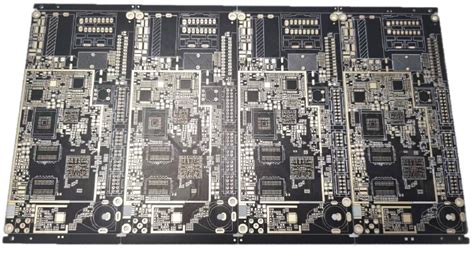The importance of PCBs in the automotive industry
PCBs are essential components in the automotive industry, as they provide the foundation for electrical systems and electronic devices in vehicles. Some of the key applications of Automotive PCBs include:
- Engine control units (ECUs)
- Infotainment systems
- Advanced driver assistance systems (ADAS)
- Vehicle networking and communication
- Power management and distribution
- Lighting control
- Sensors and actuators
The increasing complexity of automotive electronics has led to a growing demand for high-quality, reliable, and durable PCBs that can withstand the harsh operating conditions in vehicles, such as extreme temperatures, vibrations, and moisture.
Market growth and trends
The automotive PCB market is experiencing significant growth, driven by several factors:
- Increasing demand for electric vehicles (EVs) and hybrid electric vehicles (HEVs)
- Growing adoption of advanced driver assistance systems (ADAS) and autonomous driving technologies
- Rising demand for connected and smart vehicles
- Stringent emissions regulations and fuel efficiency standards
- Increasing vehicle electrification and digitalization
According to recent market research reports, the global automotive PCB market is expected to grow at a CAGR of around 7% during the forecast period of 2021-2026, reaching a market size of over $14 billion by 2026.
| Year | Market Size ($ Billion) |
|---|---|
| 2021 | 9.5 |
| 2022 | 10.2 |
| 2023 | 10.9 |
| 2024 | 11.7 |
| 2025 | 12.5 |
| 2026 | 14.0 |
Challenges and opportunities
While the automotive PCB industry is rapidly growing, it also faces several challenges:
- Increasing complexity of automotive electronics
- Stringent quality and reliability requirements
- Cost pressure and price competition
- Supply chain disruptions and component shortages
- Rapid technological advancements and shorter product life cycles
Despite these challenges, the automotive PCB industry also presents significant opportunities for PCB manufacturers and suppliers:
- Development of advanced and high-performance PCB materials and technologies
- Increasing demand for flexible and miniaturized PCBs
- Growing adoption of 5G technology in connected vehicles
- Expansion into emerging markets and regions
- Collaborations and partnerships with automotive OEMs and Tier-1 suppliers

Key players in the automotive PCB industry
The automotive PCB industry is highly competitive, with several key players operating in the market. Some of the leading companies in the automotive PCB industry include:
- Nippon Mektron
- Meiko Electronics
- KCE Electronics
- CMK Corporation
- Unimicron
- Tripod Technology
- Chin-Poon Industrial
- Daeduck Electronics
- Simmtech
- Samsung Electro-Mechanics
These companies are investing heavily in research and development, expanding their production capabilities, and forming strategic partnerships to meet the growing demand for automotive PCBs and stay ahead of the competition.
Future outlook and trends
The automotive PCB industry is expected to continue its rapid growth in the coming years, driven by the increasing adoption of advanced electronics and technology in vehicles. Some of the key trends and developments that are likely to shape the future of the automotive PCB industry include:
- Increasing adoption of advanced PCB materials, such as high-frequency and high-speed laminates
- Growing demand for flexible and stretchable PCBs for applications such as sensors and wearables
- Adoption of additive manufacturing and 3D printing technologies for rapid prototyping and customization
- Increasing use of embedded components and system-in-package (SiP) solutions
- Growing emphasis on sustainability and environmentally friendly PCB manufacturing processes
As the automotive industry continues to evolve and embrace new technologies, the automotive PCB industry will play a crucial role in enabling the development of safer, more efficient, and more connected vehicles.
FAQ
-
What are automotive PCBs, and how do they differ from regular PCBs?
Automotive PCBs are printed circuit boards specifically designed and manufactured for use in vehicles. They differ from regular PCBs in terms of their enhanced durability, reliability, and ability to withstand harsh operating conditions, such as extreme temperatures, vibrations, and moisture. -
What are the key applications of automotive PCBs in vehicles?
Automotive PCBs are used in various applications in vehicles, including engine control units (ECUs), infotainment systems, advanced driver assistance systems (ADAS), vehicle networking and communication, power management and distribution, lighting control, and sensors and actuators. -
What are the main drivers of growth in the automotive PCB industry?
The main drivers of growth in the automotive PCB industry include the increasing demand for electric vehicles (EVs) and hybrid electric vehicles (HEVs), the growing adoption of advanced driver assistance systems (ADAS) and autonomous driving technologies, the rising demand for connected and smart vehicles, stringent emissions regulations and fuel efficiency standards, and increasing vehicle electrification and digitalization. -
What are some of the challenges faced by the automotive PCB industry?
Some of the challenges faced by the automotive PCB industry include the increasing complexity of automotive electronics, stringent quality and reliability requirements, cost pressure and price competition, supply chain disruptions and component shortages, and rapid technological advancements and shorter product life cycles. -
What are the future trends and developments expected in the automotive PCB industry?
Some of the future trends and developments expected in the automotive PCB industry include the increasing adoption of advanced PCB materials, growing demand for flexible and stretchable PCBs, adoption of additive manufacturing and 3D printing technologies, increasing use of embedded components and system-in-package (SiP) solutions, and growing emphasis on sustainability and environmentally friendly PCB manufacturing processes.






Leave a Reply